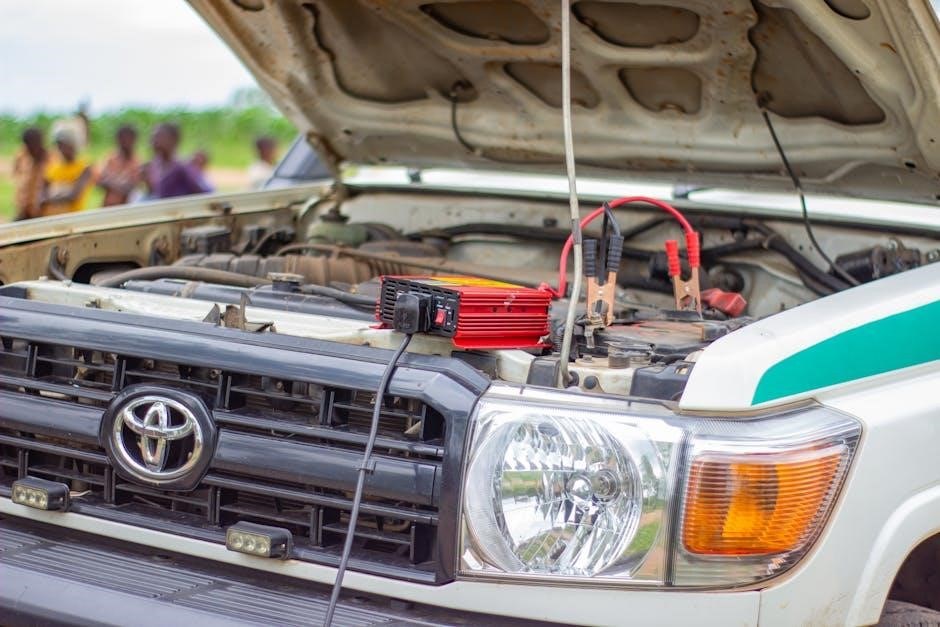Kings 40A DCDC Charger Manual: A Comprehensive Guide

Embark on a seamless journey with your Kings 40A DCDC Charger. This comprehensive guide unlocks its full potential. Discover detailed instructions‚ safety protocols‚ and troubleshooting tips. Navigate its features and ensure optimal performance. This manual empowers you for efficient battery charging.
The Kings 40A DCDC charger represents a leap forward in auxiliary battery charging technology‚ designed for adventurers and off-road enthusiasts alike. This device ensures your auxiliary batteries receive optimal charging‚ regardless of your vehicle’s alternator type. It’s a multi-stage charger‚ compatible with various battery chemistries including Lithium‚ AGM‚ and Lead Acid. It offers a seamless charging experience.
Its built-in MPPT solar regulator provides an additional charging source‚ harnessing solar power to keep your batteries topped up while reducing your reliance on the vehicle’s electrical system. The Kings 40A DCDC charger is more than just a charger. It’s a comprehensive power management solution; Its robust design ensures durability in harsh environments.
This introduction sets the stage for a deep dive into the charger’s capabilities‚ guiding you through its features‚ installation‚ and operation. Whether you’re a seasoned overlander or new to dual-battery systems‚ understanding the Kings 40A DCDC charger is crucial for maximizing your off-grid power potential. This manual serves as your primary resource for unlocking its many benefits.
Safety Information and Precautions
Prioritizing safety is paramount when operating the Kings 40A DCDC Charger. This device involves electrical connections and high currents‚ demanding strict adherence to safety guidelines. Before installation or use‚ thoroughly read this manual. Ensure you comprehend all warnings and instructions. Incorrect installation or operation can lead to equipment damage‚ personal injury‚ or even fire.
Always disconnect the vehicle’s battery negative terminal before commencing any wiring. This prevents accidental shorts. Verify the charger’s input voltage matches your vehicle’s electrical system (12V or 24V). Never expose the charger to excessive moisture or extreme temperatures. Mount the charger in a well-ventilated area‚ away from flammable materials. Regularly inspect wiring for damage or loose connections.
If you notice unusual smells‚ smoke‚ or excessive heat‚ immediately disconnect the charger and seek professional assistance. Do not attempt to repair the charger yourself; this voids the warranty and poses significant safety risks. When working with batteries‚ wear appropriate personal protective equipment‚ including safety glasses and gloves. By diligently following these safety precautions‚ you can ensure the safe and reliable operation of your Kings 40A DCDC Charger.
Understanding the Specifications of the 40A DCDC Charger
To maximize the Kings 40A DCDC Charger’s performance‚ understanding its specifications is crucial. This charger is designed for 12V/24V input and delivers a maximum charging current of 40 Amps. It employs a multi-stage charging algorithm‚ optimizing battery health and longevity. The charger supports various battery types‚ including AGM‚ Lithium‚ and Lead-Acid‚ selectable via a user-friendly interface.
The built-in MPPT (Maximum Power Point Tracking) solar regulator enhances solar panel integration‚ maximizing energy harvest. Input voltage ranges from 12V to 24V DC‚ accommodating various vehicle systems. The charger features over-voltage‚ over-current‚ and over-temperature protection‚ ensuring safe operation. Its IP66 rating signifies resistance to dust and water ingress‚ making it suitable for harsh environments.
The charger’s dimensions and weight are specified in the manual‚ aiding installation planning. Its operating temperature range is also crucial for proper function. The manual details the charger’s efficiency‚ indicating how much input power is converted to charging output. Understanding these specifications empowers users to optimize charging parameters‚ select compatible batteries‚ and ensure the Kings 40A DCDC Charger operates within its design limits for reliable performance.
Installation Guide for the Kings 40A DCDC Charger
Proper installation is paramount for the Kings 40A DCDC Charger’s optimal performance and longevity. Begin by selecting a suitable‚ dry location within your vehicle or caravan‚ as close as possible to the auxiliary battery. Ensure adequate ventilation to prevent overheating. Disconnect the vehicle’s starter battery’s negative terminal before commencing installation.

Securely mount the charger using appropriate hardware‚ ensuring it’s protected from physical damage and vibration. Connect the positive and negative cables from the starter battery to the charger’s input terminals‚ adhering to the correct polarity. Connect the charger’s output terminals to the auxiliary battery‚ again ensuring correct polarity. Use appropriately sized wiring and fuses‚ as specified in the manual‚ to handle the 40A current.
If integrating solar panels‚ connect them to the charger’s solar input terminals‚ following the manual’s wiring diagram. After verifying all connections‚ reconnect the starter battery’s negative terminal. Consult the user manual for detailed wiring diagrams and torque specifications. A well-executed installation ensures the Kings 40A DCDC Charger operates efficiently and safely‚ providing reliable charging for your auxiliary battery system. Always double-check all connections before powering on the system.
Wiring Diagram and Connections
Understanding the wiring diagram is crucial for a successful and safe installation of the Kings 40A DCDC Charger. The diagram illustrates the precise connections between the charger‚ the starter battery‚ the auxiliary battery‚ and optional solar panels. Carefully study the diagram before making any connections.
The charger typically has input terminals for connecting to the starter battery (positive and negative) and output terminals for connecting to the auxiliary battery (positive and negative). Ensure the correct polarity is maintained throughout the wiring process. Reversing the polarity can damage the charger and the batteries. When integrating solar panels‚ connect them to the designated solar input terminals on the charger‚ paying attention to the voltage and current ratings specified in the manual.
Use appropriately sized wiring to handle the current‚ typically with a 50A wiring kit recommended‚ and fuses to protect the system from overloads. Securely connect all wires‚ ensuring tight and corrosion-resistant connections. Refer to the manual for recommended wire gauges and fuse sizes. A clear understanding of the wiring diagram and meticulous attention to detail are essential for a reliable and safe charging system. Always double-check all connections before applying power. Miswiring can lead to damage or even fire.

Operating Instructions and Mode Selection (Lithium‚ AGM‚ etc.)
The Kings 40A DCDC Charger offers versatile charging capabilities for various battery types‚ including Lithium‚ AGM‚ and Lead Acid; Selecting the correct charging mode is essential for optimal battery performance and longevity. Consult the charger’s manual and your battery manufacturer’s specifications to determine the appropriate mode.
To select the desired mode‚ locate the mode selection button on the charger unit. Typically‚ a push-button interface allows cycling through the available modes. The charger may have indicator lights to display the selected mode. Ensure that the correct mode is selected before initiating the charging process. For Lithium batteries‚ use the Lithium (LiFePO4) setting to ensure proper voltage and current profiles. For AGM or Lead Acid batteries‚ select the corresponding mode.
Once the mode is selected‚ the charger automatically manages the charging process. It typically employs a multi-stage charging algorithm‚ including bulk‚ absorption‚ and float stages. Monitor the charging progress using the charger’s indicator lights or a connected Bluetooth app (if available). Avoid interrupting the charging cycle unless necessary. The manual provides detailed information on the charging stages and expected charging times. Incorrect mode selection can lead to undercharging‚ overcharging‚ or battery damage‚ so always verify the setting before operation.
Troubleshooting Common Issues: Charger Not Lighting Up/Turning On
If your Kings 40A DCDC Charger fails to power on‚ several factors could be responsible. Firstly‚ verify the input voltage from your vehicle’s cranking battery. The charger needs a minimum voltage to operate‚ often around 13.2V when the engine is running or 12.0V for vehicles with smart alternators and the ignition cable connected. Check the voltage using a multimeter at the charger’s input terminals.
Next‚ inspect all wiring connections for looseness or corrosion. Ensure the positive and negative cables are securely connected to both the cranking battery and the charger. Check the fuse on the positive input cable and replace if necessary. If the fuse repeatedly blows‚ it indicates a short circuit in the wiring.
Furthermore‚ confirm the charger is properly grounded to the vehicle’s chassis. A poor ground connection can prevent the charger from functioning correctly. Clean the grounding point and ensure a tight connection. If the issue persists‚ consult the Kings 40A DCDC Charger manual for further troubleshooting steps or contact customer support. Remember to disconnect all power sources before performing any electrical checks or repairs. Incorrect troubleshooting may damage the unit.
Understanding Error Codes and Their Meanings
The Kings 40A DCDC Charger‚ like many modern electronic devices‚ uses error codes to communicate potential problems. These codes‚ displayed on the charger’s interface‚ offer valuable insight into the nature of any malfunction‚ allowing for quicker and more effective troubleshooting. Each code corresponds to a specific issue‚ ranging from input voltage problems to battery overcharging or overheating.
Consult your Kings 40A DCDC Charger manual for a comprehensive list of error codes and their meanings. Typically‚ the manual provides a detailed explanation of each code‚ along with recommended actions to resolve the underlying issue. For example‚ an error code indicating low input voltage might suggest checking the vehicle’s alternator or battery connections.
Similarly‚ a code signaling battery overcharging could point to a faulty voltage regulator or an incorrect battery type setting. When an error code appears‚ note it down and refer to the manual immediately. Avoid attempting to diagnose or repair the charger without understanding the code’s meaning. Ignoring error codes or attempting unqualified repairs could lead to further damage and void the warranty. If unsure‚ contact Kings customer support for assistance.

Solar Panel Integration and MPPT Functionality
The Kings 40A DCDC Charger boasts seamless solar panel integration‚ enhancing its versatility for off-grid adventures. A key feature is its built-in MPPT (Maximum Power Point Tracking) functionality. MPPT is a sophisticated algorithm that optimizes the energy harvested from your solar panels. It constantly adjusts the voltage and current to extract the maximum power available at any given time. This maximizes charging efficiency‚ especially in varying sunlight conditions.
Connecting your solar panels is straightforward‚ usually involving dedicated solar input terminals on the charger. Ensure your solar panel’s voltage is within the charger’s specified input range‚ typically a 12V nominal panel with a Voc (open-circuit voltage) less than 25V. The charger’s MPPT then takes over‚ automatically adapting to the panel’s output to deliver the optimal charging current to your auxiliary battery.
The solar priority charging feature intelligently utilizes solar power first‚ supplementing it with the vehicle’s alternator only when needed. This reduces strain on your vehicle’s electrical system and prioritizes renewable energy. Refer to the Kings 40A DCDC Charger manual for detailed wiring diagrams and specific solar panel compatibility information. Proper solar panel integration ensures efficient and sustainable battery charging wherever your adventures take you.
Maintenance and Care Tips
To ensure the longevity and optimal performance of your Kings 40A DCDC Charger‚ regular maintenance and care are essential. Firstly‚ routinely inspect the charger’s wiring connections for any signs of corrosion‚ looseness‚ or damage. Tighten any loose connections and replace any damaged wiring immediately. Keep the charger clean and free from dust‚ dirt‚ and moisture. Use a dry cloth to wipe down the exterior of the charger regularly.
Ensure the charger is located in a well-ventilated area to prevent overheating. Avoid exposing the charger to extreme temperatures or direct sunlight for extended periods. Periodically check the charger’s cooling fan (if equipped) to ensure it is functioning correctly. If the fan is clogged with debris‚ clean it carefully. Before cleaning or performing any maintenance‚ disconnect the charger from both the vehicle’s starting battery and the auxiliary battery.
If you notice any unusual noises‚ smells‚ or performance issues‚ consult the troubleshooting section of the user manual or contact Kings customer support for assistance. Avoid attempting to repair the charger yourself‚ as this may void the warranty. Store the charger in a dry‚ safe place when not in use. Following these simple maintenance and care tips will help keep your Kings 40A DCDC Charger operating reliably for years to come.
Compatible Battery Types and Capacity
The Kings 40A DCDC Charger is designed to be compatible with a variety of 12V battery types‚ offering flexibility for different applications. It supports Lead Acid batteries‚ including Wet‚ Gel‚ AGM (Absorbent Glass Mat)‚ and Calcium types. Furthermore‚ it is also compatible with Lithium-ion batteries‚ specifically Lithium Iron Phosphate (LiFePO4) batteries‚ which are becoming increasingly popular due to their high energy density and long lifespan.
When selecting a battery for use with the charger‚ it is important to consider the recommended battery capacity. For optimal performance and to avoid overcharging or damaging the battery‚ it is generally recommended to use batteries within a certain capacity range. For the Kings 40A DCDC Charger‚ a battery capacity between 120Ah and 400Ah is typically suitable for most Lithium batteries. When using Lead Acid based batteries‚ a battery capacity of 80Ah to 250Ah is recommended for the 25A DCDC models.
Always refer to the user manual for the specific recommended battery capacity range for your particular charger model. Selecting the correct battery type and capacity is crucial for ensuring safe and efficient charging‚ maximizing battery life‚ and preventing any potential damage to the charger or the battery. Incorrect settings can lead to reduced performance or even hazardous situations.
Where to Find the User Manual and Support Resources
Locating the user manual for your Kings 40A DCDC Charger and accessing support resources is crucial for optimal usage and troubleshooting. The primary location for the user manual is often the official Adventure Kings website or the 4WD Supa Centre website‚ where you can typically find a downloadable PDF version. Search for your specific model number (e.g.‚ AKEP-DCDC40A_01) to ensure you obtain the correct manual.
In addition to the official websites‚ you can sometimes find the user manual on online forums and communities related to camping‚ caravanning‚ and 4WD enthusiasts. These platforms often host discussions and shared resources‚ including user manuals and troubleshooting tips. Retailers like BCF (Boating Camping Fishing) may also provide access to the manual on their product pages.
For support resources‚ consider contacting Adventure Kings or 4WD Supa Centre directly through their customer service channels. They usually offer phone support‚ email support‚ and online chat options. Enerdrive and Dometic‚ other providers of mobile power products‚ may also offer relevant support information. Furthermore‚ checking online platforms such as YouTube can provide helpful video tutorials and user-generated content demonstrating installation‚ operation‚ and troubleshooting techniques for the Kings 40A DCDC Charger. Remember to always prioritize official sources for the most accurate and up-to-date information.

